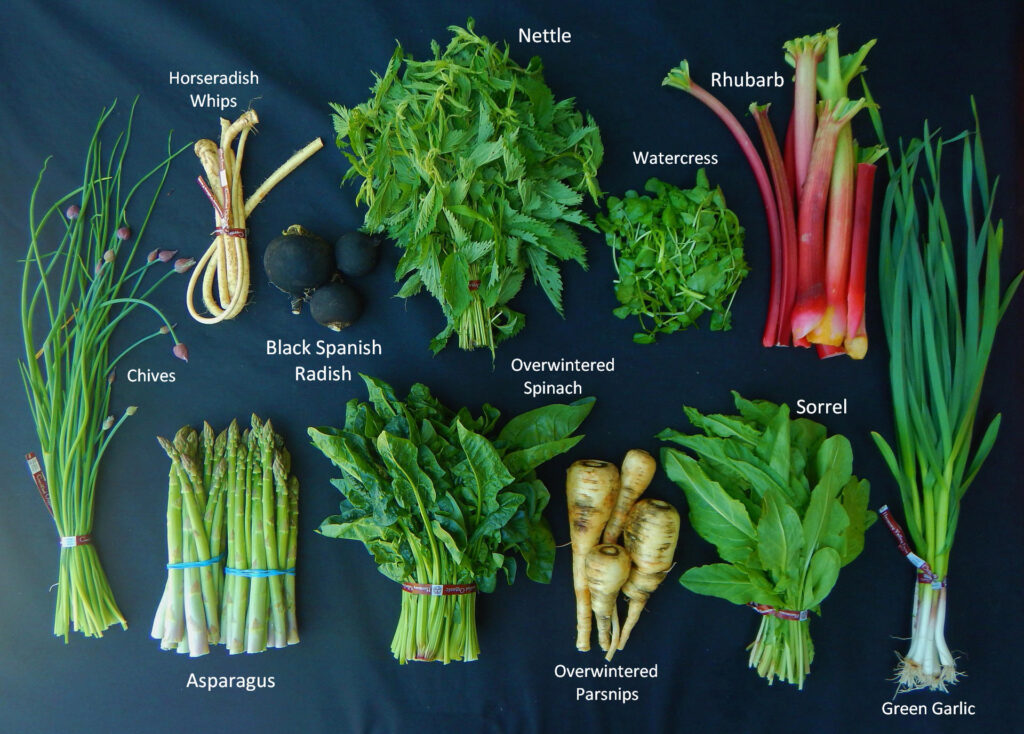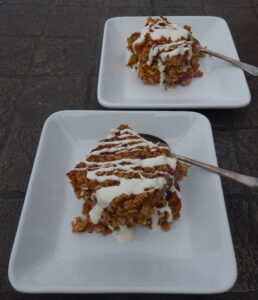What’s In The Box with Recipe Suggestions
Green Garlic: While this resembles a green onion, it’s actually an immature garlic plant. It’s tender enough at this stage to use the entire plant including the green leaves, main stem and lower portion.
Creamy Green Garlic & Feta Dressing
Chives: These are the long slender, spiky vegetable with a bold onion flavor. There may be purple buds or flower blossoms in your bunch. These are edible too!
Nettle & Wild Onion Rice Balls
Roasted Radish and Herbed Ricotta Omelet
Sorrel: This is the bunched green in your box with brightly colored leaves and hints of pink in the veins. The leaves are long, and arrow shaped. The flavor of this green is bright and lemony. You can eat it both raw and cooked.
Frosty Sorrel & Banana Smoothie
Armenian Cold Yogurt & Sorrel Soup
Cream of Asparagus & Sorrel Soup
Watercress: This peppery green is excellent in fresh salads, sandwiches and wraps, but it is also often used in spring soups along with potatoes, etc. We have washed it, but you may need to give it another washing in your kitchen sink before you use it to remove any fine silt that may be on the stems. It is a more perishable green, so we recommend you use it within a week.
Watercress Soup with Horseradish Cream
Broiled Bacon-Wrapped Chicken with Sweet Potatoes and Watercress
Nettles: important information— This bunched green is also called “Stinging Nettles” due to the “stingers” they have on their stems that can cause skin irritation if handled before they are cooked. For this reason, we have packed the nettles in a clear plastic bag. Before you open the bag, we encourage you to read our previous blog post from 2018 for important information about how to handle and prepare nettles. Once nettles are cooked, the sting goes away, and you can handle them with bare hands. They are packed with nutrients and are very flavorful.
Nettle & Mushroom Pizza with Ramp Cream
Asparagus: Store asparagus in the refrigerator, upright in a glass of water or just wrap the base of the bunch with a moist paper towel and store it in a plastic container to keep it fresh and crisp.
Cream of Asparagus & Sorrel Soup
Cream of Asparagus and Parsnip Soup
Overwintered Parsnips: These parsnips are a great example of ‘funny shaped’ food that is still tasty and nutritious. They were dug in the spring and are very sweet and flavorful. It’s not uncommon to see some browning on the skin. Peel away the skin and they are solid and snow white on the inside! Store them in the refrigerator in a plastic bag and use them within a few weeks.
Parsnip, Lemon & Poppy Seed Muffins with Lemon Drizzle
Black Spanish Radishes: Black as the darkest night on the outside and snow white on the inside, you can read more about this mysterious looking root in this week’s vegetable feature article. Store them in a plastic bag in the refrigerator until you are ready to use them.
Barbecue Seasoned Roasted Roots & Tubers
Black Spanish Radish & Apple Slaw with Honey Vinaigrette
Horseradish Whips: We packed a ¼-pound portion for you this week. These thin pieces are called “whips” and grow off the main root. Horseradish stores for a long time, so just keep it in the bag and store it in the refrigerator until you’re ready to use it!
German Braised Pork with Horseradish Sauce
Overwintered Spinach: This is the last week for our overwintered spinach. This spinach was planted in the field last fall. This spinach has thick, tender leaves and is some of the most flavorful you’ll eat this season! The leaves are thick, yet tender. You may eat spinach raw or cook it. Store spinach in the bag and keep it in the refrigerator.
Spring Spinach Chop Salad with Creamy Buttermilk Ramp Dressing
Easy Crust-less Spinach and Feta Pie
Rhubarb: This week’s boxes contain about 1.25# of rhubarb. If you don’t want to use it right away, dice it up and put it in a freezer bag. You can successfully freeze raw rhubarb which may be used later in the year in baked goods, sauces, drinks, etc.
Persian Rhubarb Stew (Khoresh Rivas)
Vegetable Feature: Rhubarb

Rhubarb is a vegetable, although it is most often used like a fruit. Rhubarb is a perennial crop, and it takes several years to build up the energy reserves in the rhizome. Thus, we don’t harvest rhubarb until, at the very earliest, the third year. We remove the leaves in the field because they should not be consumed or eaten.
Rhubarb has a distinct, unique flavor that is quite good. It may be eaten raw or cooked, however it’s pretty tart and it is most often cooked first. Over the years it became known in some areas as “The Pie Plant” because it is most often used in pies. While the sweetness of baked goods helps to counterbalance the tartness of rhubarb, this vegetable can also be used in savory preparations. Instead of masking the characteristic tartness of rhubarb with sugar, why not use those innate qualities to your advantage?! It can be used to create a flavorful braising liquid or sauce to serve with pork, duck, chicken thighs or other fatty meats. The flavor of rhubarb can stand up to bolder spices such as curry powder, cardamom, peppercorns, cinnamon and ginger, thus rhubarb chutney can make a nice accompaniment to Indian curry dishes or serve it with grilled or roasted meats. Rhubarb compote or chutney is also delicious served simply as a snack with cream cheese and crackers! Rhubarb can also be used as a stir-fry vegetable, added towards the end of cooking so it just starts to soften, but still holds its shape.
Whether sweet or savory, there are so many things you can do with rhubarb. If you can’t decide what to make now and need some time to think it over, you can easily preserve rhubarb by freezing it. Just wash the stalks, cut them into bite-sized pieces and put them in a freezer bag to pop in the freezer. Perhaps you’ll come up with just the right use for it sometime during the winter!
Short & Sweet Weekly Farm Update
Wow, it has been a really busy week! We are on week number 2 of dry weather and the crew and fields are loving it. But now we are ready for some rain. Manuel Morales and his irrigation crew have been working hard at setting up the irrigation equipment and keeping those little seedlings from drying out.

There are so many little green vegetables coming through the soil that I can’t even name them all. But I can tell you that next week we are extremely optimistic that you will see baby spinach, spring radishes and arugula in your share boxes.
Speaking of CSA share boxes, we are also planning on sending the first week of herb packs next week. Watch for more information about the herbs next week! We have a 4 acre field mulched and ready for tomato pepper eggplant seedlings 1st sweet corn and green/yellow beans and peas are coming up.






